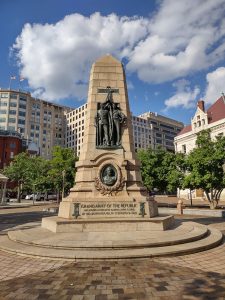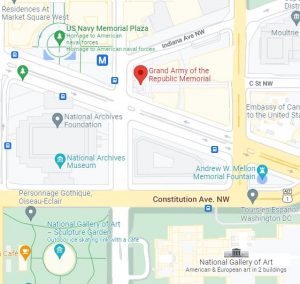ECW Weekender: The Grand Army of the Republic Memorial in Washington, DC
Washington, DC is filled with monuments and memorials dedicated to the people and events key to American history. Among that immense number are several that honor people involved in the Civil War. Most are heroic equestrian statues of US generals, and one could easily argue that the Lincoln Memorial is a Civil War monument. There’s even a memorial honoring nuns who cared for the sick and wounded during the war. Among this list is a 25 foot granite shaft located near the intersection of 7th Street and Pennsylvania Avenue dedicated to Union veterans and the organization that advocated for them after the war.
 The monument pulls double-duty, representation Benjamin Stephenson as well as the Grand Army of the Republic as a whole. Dr. Stephenson, who served as a surgeon during the war, founded the Grand Army of the Republic in 1866 and died in 1871 before the organization reached its apex. The GAR was the largest veterans organization, accepting both soldiers and sailors, white and black, officers and enlistedmen into its ranks. Swelling to over 400,000 members, the organization and its members loudly advocated for veterans for the rest of their lives. It wielded strong political influence to support political candidates, strengthen the veteran pension system, and support newly-established Memorial Day as a holiday. Rather than solely memorializing the wartime service of Stephenson and his GAR comrades, it honors their postwar accomplishments as well.
The monument pulls double-duty, representation Benjamin Stephenson as well as the Grand Army of the Republic as a whole. Dr. Stephenson, who served as a surgeon during the war, founded the Grand Army of the Republic in 1866 and died in 1871 before the organization reached its apex. The GAR was the largest veterans organization, accepting both soldiers and sailors, white and black, officers and enlistedmen into its ranks. Swelling to over 400,000 members, the organization and its members loudly advocated for veterans for the rest of their lives. It wielded strong political influence to support political candidates, strengthen the veteran pension system, and support newly-established Memorial Day as a holiday. Rather than solely memorializing the wartime service of Stephenson and his GAR comrades, it honors their postwar accomplishments as well.
The triangular granite shaft was dedicated July 3, 1909. The front face displays bronze figures of a soldier and a sailor as well as a portrait of Dr. Stephenson, who never saw his organization reach the national prominence it eventually did. That face loudly decrees the virtue of FRATERNITY, while the other two faces of a woman protecting a child and a second woman with sword and shield proclaim CHARITY and LOYALTY respectively.

Located just north of the National Mall, the monument occupies a corner with unique buildings just across from the National Archives. Though smaller than the grand monuments that dominate the viewshed and capture the imagination, this humble yet striking monument to what US veterans accomplished after the war is worth a visit the next time you conduct research in the National Archives or visit the National Mall.

The Veteran’s Organizations were increasingly controversial into the 1880s as the amount of public money’s that went to veteran’s payments came to almost 4 billion dollars by the early 1890s.